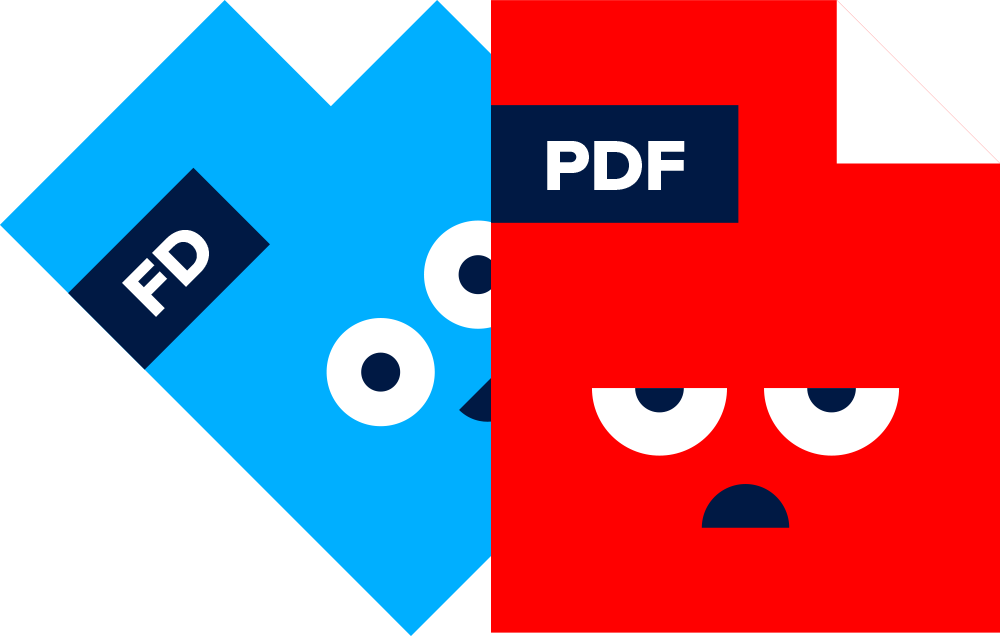I don’t need 1,500 words to tell you just how dead PDFs are when delivering interactive and entertaining online content.
I can do it in two: mobile-friendly.
You shouldn't even be thinking about animating or introducing interactivity to your PDF content to make it more exciting, engaging, or fun to read, which, let’s face it, will probably only work in some PDF viewers.
They won't be any use if the text is so small you need a microscope to read it or a bionic thumb for all the sideways scrolling you’ll need to do once you’ve zoomed in far enough.
Nope. PDFs aren’t responsive, so in our mobile-driven society, they’re pretty useless on anything smaller than a tablet or laptop. Okay, there’s Acrobat’s Liquid Mode, but are you really going to download every PDF you come across and open it in another app to access their content? No, of course not. Nobody’s got time for that.
We all have our strengths and weaknesses—let’s keep PDFs for what they’re good at and find a better option to replace them where they fall down.
PDFs are built for print—let’s let them thrive in their preferred environment
When PDFs came onto the scene, content creators threw their hats in the air, raising the mightiest of toasts to the new wonder format.
The highest hats, however, were thrown into the stratosphere by printers and publishers, delighted that they’d never have to receive another MS Word file to convert into press-ready artwork ever again.
To this day, PDF is still king amongst printers and publishers, and rightly so. So let’s keep the format playing to its strengths and remove it from where it’s no longer fit for purpose.
Isn’t it time we let the new wonders of web content replace outdated options for all our online content? Yes, absolutely it is.
Were animated PDFs ever any good?
There was a stage way back in B2B marketing trends where developers introduced plugins that converted PDF documents into animated flipbooks. That was the only meritable use of animation in a PDF. Their most interesting feature was that each page turn was animated—yes, just like they do on your Kindle. You could also link items or products to your stores or include a few buying practices in the document. Pretty cool for its day; pretty redundant now, though.
So what have we learned? Back in their day, they were moderately impressive and fun to play with—but now? There are some things we just need to let go.
What do readers really want from their content?
Talk to an SEO expert, and they’ll holler “Content is king!” from the rooftops.
Ask the reader what they want from their content, and nine times out of ten, they’ll tell you they want to find what they need to know quickly and easily and have it delivered in the simplest way to understand—also quickly and easily.
None of us has time for scouring endless blocks of information for the nuggets we need. Instead, we want to dig straight to the gold, and we want it spoon-feeding in as neat, tidy, and efficient a way as possible.
And so we’re back to the million-dollar question: What makes ideal content delivery?
What’s hot and what’s not in content consumption?
In answer to that last question, here’s what you need from your content and why you aren’t getting it from your PDFs.
What makes the first-rate experience your readers are looking for?
Well, B2B marketing trends tell us that your ideal content needs to contain elements of:
- Engagement – Readers need to feel engaged.
- Navigation – They want a simple navigation system that’s readily available and takes them straight to where they want to be.
- Interest – Your content should be visually interesting to hold attention.
- Interactivity – Finally, users love interactive features to feel part of what they’re reading.
Where does the good old PDF fall short on such features?
If you need more reasons why you shouldn’t be pursuing animations in PDFs or hosting PDFs as online content at all, then here are our top ten of hit-and-miss-but-mostly-miss inclusions for PDFs:
- Video – Directly placed or embedded, PDFs don’t do video.
- Animated GIFs – As much as the meme market can’t function without them, PDFs can’t function with them.
- Multi-state objects – Much like GIFs, you’ll only see the object's first state, if anything, from these InDesign-created additions.
- Embedded HTML – PDFs aren’t great with HTML. You can export PDFs from their creation packages as HTML5 pages, but they aren’t PDFs anymore, are they?
- Button actions – This one’s a bit like tossing a coin; depending on the action and how it was created, your users will likely be playing the ‘will they, won’t they’ game.
- Custom page transitions – Although some PDF packages export custom-page scrolling, and some do it rather well, they’re not always reliable or functional.
The time to change content delivery practices is now
Web user behaviors change faster than the weather. The ever-growing market share is a younger, modern thinking and acting generation who love devouring content in as entertaining a way as possible. The Tik-Tokkers, YouTubers, and Instagrammers want video content with links they can click at specific parts of their journeys; can a PDF do that? No. But your Foleon content or doc can.
What’s available to soothe your content lovers’ souls?
Content creation platforms help deliver professionally produced, engaging, and interactive content experiences. In more detail, we discuss the different experiences marketers can produce with a modern platform in our blog and show you how other organizations are already doing it.
- Interactive white papers – What was once dry and dated is now full of color and movement, working well for lead generation and in the buying stages of your funnel. You can check out some brilliant examples of interactive white papers here.
- Digital magazines – Mobile-friendly and versatile, digital magazines offer something at every funnel stage and deliver just as much to your readers with linkable and video content. You can track each reader’s actions in a Foleon digital magazine, allowing you to measure behavior and optimize accordingly.
- Digital reports – Reports hold the valuable data consumers are looking for to influence their decision-making. Making them mobile-friendly, interactive, and presenting your data in easier-to-understand means makes them, and you, a must for your fans. Add a little gating to the process, and they become a fabulous lead generation tool.
Here are our digital publishing Dos and Dont's - Annual reports – Whoever thought an annual report could be fun to read? Well, now they can be if you’ve got the right tools for the job. As with any digital report, there’s plenty of data to track, too, and with Foleon, now you can.
Check out our State of Digital Publishing report - Interactive newsletters – It’s time to set your email newsletters free! You’ll struggle to hold the reader’s attention by having them scroll down a lengthy email. All those long and lengthy text blocks? No, thank you. Put the same information into a more readable, attractive format with smaller, easier-to-digest chunks, and you’ll deliver a newsletter that will hold attention to the final page.
Here's our Marketing newsletter, The Crave. Click on the menu bar to explore previous editions. - Digital brochures – Even though a website is an organization’s most complete digital brochure, they can be a little too all-consuming—after all, they have to cover every angle of your business and then some. A single, simple, streamlined option can work wonders for user understanding and consumption. There’s nothing to stop you from adding links to those deeper dives where appropriate—and your beautiful digital brochures will save you a fortune on print costs!
Read more: The Benefits of Using Digital Brochures in Your Content Marketing.
Foleon handles all those elements as beautifully and as simply as you need it to. If you think adding another subscription to your system isn't cost-effective, our Director of Brand and Communications, Julie Alexander, makes a valuable argument for the ROI of interactive formats. She explains the benefits of engaging with such a content-advancing trend.
The magic of the interactive page or platform
Yes, content is king, but the experience keeps your readers on the page, converting them into customers.
To create the best content experiences (follow the link to dive into all the fine details of how Foleon delivers), here are four simple steps to enhance reader interactions:
- Use simple, seamless, and straightforward navigation
- Elevate the experience:
- Quizzes
- Calculators and tools
- Interactive infographics
- Games
- Interactive maps, webinars, videos, and film
- Memes and GIFs
- Engage and explore:
- Deliver informative, essential, and relevant information
- Make your content share-worthy and easy to share
- Invite opportunities to engage and communicate
- Keep it consistent – Ensure a steady flow of relevant and required information to keep existing readers interested and get new leads onto your hook.
Final thoughts on the sad reality of animated PDFs
As B2B marketing trends go, shifting to interactive and engaging content is a serious move for guiding opportunities down your sales funnel. Keeping all of your content bang up to date is a huge bonus, as is having teams of authors co-working on documents and projects and the added possibilities for lead generation.
Now is the time for your new content to shine, and all without the fuss of learning complicated design packages or writing a single line of code. Welcome Foleon to your tech stack, and every corner of your site’s pages, white papers, brochures, and blogs can utilize those extra tools to help them convert.
And as far as the trusty PDF goes, let’s leave it to what it does best and praise it for all of its historical successes instead of its weaknesses.
Discover: Why you should choose web publications over responsive PDF's.



